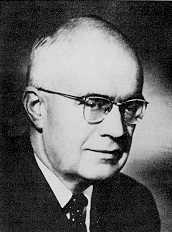| Profile | Major Works | Resources |
Oskar Ryszard Lange, 1904-1965.

Born 1904 near Lodz, Poland, the son of a textile merchant. Oskar (sometimes spelled :"Oscar") Lange studied law and economics at Poznan and Cracow, where he graduated in 1928. His socialist tendencies led him into the "neutral" camp of statistics, which he taught for several years at Cracow.
In 1934, a Rockefeller fellowship brought him to England and subsequently the United States. In 1936, Lange began teaching at the University of Michigan then, in 1938, he became a professor at the University of Chicago. Towards the end of World War II, in a highly controversial move, Lange broke with the Polish government-in-exile in London and transferred his support to the Lublin Committee sponsored by the Soviet Union. (Lange actually served as the go-between for Roosevelt and Stalin in 1944 during discussions of the post-war Polish borders and character of its government). In 1945-6, Lange left Chicago and was appointed the Polish Ambassador to the United States. In 1946, Lange served as the Polish delegate to the United Nations Security Council. He returned to Poland in 1947, where he continued working for the Polish government, while continuing his academic pursuits at the University of Warsaw and the Central School of Planning and Statistics.
The bulk of Lange's contributions to economics came during his American interlude of 1933-1945. Although an ardent socialist, Lange deplored the Marxian labor theory of value, being very much a believer in the Neoclassical theory of price. He put these two together famously in his 1938 On the Economic Theory of Socialism, where he argued that a state-run economy could at least be as efficient - if not more efficient -- than a free market economy. Lange argued that this was possible if the government planners used the price system as if in a market economy and instructed state industry managers to respond parametrically to the state-determined prices (minimize cost, etc.). Lange's argument was one of the pivots of the Socialist Calculation Debate with the Austrian School.
Although Lange flourished at the University of Chicago, he was not, of course, a member of the its more narrowly-defined "school". Rather, he remained content to consort with the Cowles Commission researchers next door. Lange became one of the leading lights of the "Paretian Revival" in general equilibrium theory during the 1930s. In 1942, he provided one of the first proofs of First and Second Welfare Theorems. He initiated the analysis of stability of general equilibrium (1942, 1944). His critique of the Quantity Theory of money (1942) prompted his student, Don Patinkin, on to his remarkable "integration" of money into general equilibrium theory. Lange also made several seminal contributions to the development of the Neo-Keynesian Synthesis (e.g. 1938, 1943, 1944).
The post-1945 period, Lange's fortunes changed. His particularly close association with the Stalinist government of Poland and his political activities on their behalf marred both his economics and his respectability in the economics profession. He was particularly taken to task by fellow economists for papers he wrote lauding Stalin as an "economic theorist" (e.g. 1953). Nonetheless, Lange never regarded himself as anything else but a socialist activist as well as Marxian economist. Neoclassical economics was always a computational tool, not an ideological one. Throughout the remainder of his life, Lange strove to bring Neoclassical pricing theory into Soviet-style economic planning practices and integrating Classical and Neoclassical economics into a single theoretical structure (e.g. 1959). In his final years, Lange worked on cybernetics and the use of computers for economic planning.
|
Major works of Oskar Lange
|
HET
|
|
Resources on Oskar Lange
|
All rights reserved, Gonšalo L. Fonseca
